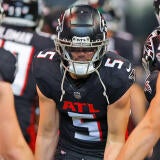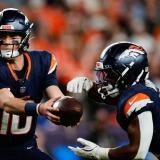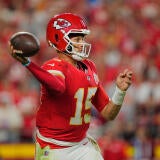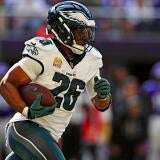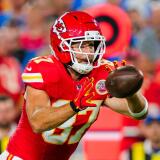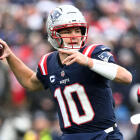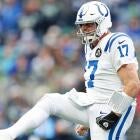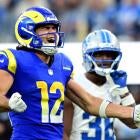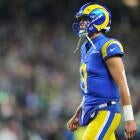
NFL Draft Reset: Cowboys go all-in on a younger, faster, more flexible defense
A look at the needs the Cowboys addressed in the draft and what it all means

The Dallas Cowboys spent the past several years building a top-flight offense through a combination of heavy first-round investment in the offensive line (All-Pros Tyron Smith, Travis Frederick and Zack Martin), running back (All-Pro Ezekiel Elliott) and wide receiver (All-Pro Dez Bryant). They also unearthed prime talents elsewhere in undrafted free-agent wideout Cole Beasley and especially lightning-in-a-bottle fourth-round quarterback and 2016 Offensive Rookie of the Year Dak Prescott. The Cowboys spent several draft picks and a significant portion of their free-agent dollars on defense during that time, but the unit was still lagging behind entering the 2017 offseason. That needed rectifying.
It became evident over the past few years that the Dallas defense was older, slower and not nearly as versatile as it needed it to be. The Cowboys have been trying to change that over the course of a few years, and the strategy came to a head this offseason. The Cowboys sat and watched this winter as three defensive starters and three more heavy rotational players from last year's 13-3 team walked out the door in free agency.
The secondary, which emerged as a quiet strength during the 2016 season, was hit especially hard. Barry Church, Brandon Carr and J.J. Wilcox all got sizable multiyear deals to leave Big D, and Morris Claiborne got paid more than Jerry and Stephen Jones were willing to pony up on a one-year contract. But it wasn't just the secondary that got pillaged. Valuable defensive lineman Terrell McClain defected to division rival Washington on a long-term deal and rotational pass-rusher Jack Crawford joined the Falcons.
The Cowboys made all of three acquisitions to replace those six players, with only one being given any guaranteed money beyond this season: nickel corner Nolan Carroll, who was signed along with defensive linemen Stephen Paea and Damontre Moore. Heading into the draft, the Cowboys had over 2,300 defensive snaps to replace. You would be hard pressed to say they didn't attack their needs with fervor during the draft this past weekend.
Grabbing a Taco
Dallas has had trouble rushing the passer for years -- essentially, since the team cut ties with DeMarcus Ware due to salary cap concerns before the 2014 season. It has come back to bite them in a big way during their past two playoff appearances, where not being able to get pressure on Aaron Rodgers has foiled their hopes for victory at the worst possible time. That's why their first-round pick this year was Michigan's Taco Charlton, a 6-foot-6, 277-pound defensive end who raised his sack total with each passing season in Ann Arbor, culminating with 10 of them in 2016. (He also raised his tackle and tackle for loss totals each year.)

Secondary a priority
With Carr, Claiborne, Church and Wilcox all moving on, two of the three corners on the roster aged 30 or older (Carroll and Orlando Scandrick) and the two safeties in line for an increase in snaps being relatively inexperienced, the Cowboys also came into the draft with glaring needs in the secondary. They spent their second- and third-round picks on two of the best cover corners in the class (Colorado's Chidobe Awuzie and Michigan's Jourdan Lewis), dealt away next year's fifth-rounder for one of their favorite safety prospects when he unexpectedly fell into the sixth round (Louisiana Tech's Xavier Woods) and spent a seventh on a corner from one of the best teams in the country that had shined as a junior before dropping off during his senior season (Florida State's Marquez White).
The themes that stuck out with all five players, as well as seventh-round defensive linemen Joey Ivey (Florida) and Jordan Carrell (Colorado) were athleticism and versatility. Looking back on the defensive players the Cowboys selected (and scooped up as undrafted free agents) in the past few drafts, it's obvious those traits were a focus there as well. This offseason featured the largest haul in terms of numbers, but an effort to get younger, faster and more flexible on defense has been in the works for the past few years. It just culminated this offseason when free-agent defections coincided with a draft class that aligned perfectly with their needs.
Flexy time
In 2015, the Cowboys spent their first-round pick on Byron Jones, who was the breakout star of the 2015 combine when he set a world record for the broad jump. Jones ranked first among all corners in SPARQ, with an athleticism grade that placed him in the 99th percentile among NFL cornerbacks. That draft saw the Cowboys pick up four more defensive players, three of whom also graded highly in SPARQ: Randy Gregory, ranked eighth among all edge rushers and in the 92nd percentile among NFL players at the position; Ryan Russell, a defensive end ranked 20th and in the 66th percentile; and linebacker Mark Nzeocha, who ranked second and in the 95th percentile. The only defensive player they selected that wasn't an elite athlete was linebacker Damien Wilson, who they took because of his ability to play both the middle and the strong side. Two seasons into their careers, Jones is the Cowboys' free safety and a rising stud; Wilson is a rotational linebacker and in the mix to start at SAM next season; Nzeocha has contributed on special teams and figures to work into the mix more in 2017; Russell was cast aside; and Gregory flashed in his first career game before getting injured and then possibly smoking himself out of the league.
Still, the Cowboys doubled down on flexy defensive athletes during the 2016 draft. Notre Dame linebacker Jaylon Smith was considered maybe the best player in the whole draft before a knee injury and subsequent nerve damage knocked him out of the first round entirely, but the Cowboys scooped him up knowing he would at least red shirt in 2016 and maybe never recover to full strength again. He has been wearing a drop-foot brace this offseason but the Cowboys have been talking lately about how much nerve regeneration he has had in his knee. Jerry even floated the idea that he could be at full strength by the start of the 2017 season. Later in the draft, the Cowboys nabbed Maliek Collins, who ranked 27th among 167 interior defensive linemen in SPARQ; Charles Tapper, fourth among defensive ends and in the 85th percentile; and Kavon Frazier, 16th among safeties and 76th percentile. The only non-elite athlete they took was Anthony Brown, who they grabbed in the sixth round because they thought he could play both in the slot and on the outside.
Smith and Tapper sat out all of 2016 with injuries and Frazier didn't see much action, but Collins started every game after Week 2, led the defensive line in snaps and finished second in sacks. The list of rookie defensive tackles to record at least five quarterback takedowns this century includes only 13 other players, and you've heard of them all. Brown wound up playing far more than anyone expected, as he was on the field for over 70 percent of Dallas' defensive snaps. He played inside and out, just as Dallas thought he could, and he acquitted himself quite nicely, especially down the stretch of the season.
Add those two classes to DeMarcus Lawrence (34th among edge rushers in 2014) and Anthony Hitchens (23rd among linebackers), as well as 2015 free-agent signing David Irving (second among interior defensive linemen), who they signed off the Chiefs practice squad, and you have 10 heavy contributors 25 or younger this coming season on defense, as well as two probable rotational backups, and nearly all of them are either top-class athletes, able to play multiple positions, or both.
The same is true of this year's picks. Charlton ranked 21st among edge rushers in SPARQ, and he played on both the right and left sides at Michigan, as well as in the interior. He also ranked third among the top-20 defensive ends in the class in production ratio (sacks plus tackles for loss divided by games played) during the 2015 and '16 seasons. Awuzie ranked tied for fourth and in the 97th percentile among corners in SPARQ. He played the nickel as a freshman, moved full-time to safety as a sophomore, and then split time between boundary corner and the slot during his junior and senior seasons.

Lewis didn't have high SPARQ grades but he's a two-time first-team All-American who played both inside and out and practically got the Revis treatment (i.e., quarterbacks ignored his side of the field) at times. He allowed all of seven completions as a senior at Michigan. White also did not rank highly but he played inside and out and looked like a star at times in 2015, when he had the good fortune of playing across from Jalen Ramsey. His play dipped as a senior, but the Cowboys are betting they can tap back into it.
Woods ranked 30th among 234 safeties in SPARQ, showed the ability to drop down inside and play man coverage against receivers, and had an incredible 14 interceptions, 18 passes defensed, six forced fumbles and four sacks during his career at Louisiana Tech.
The final analysis
Again, athletes with flexibility and play-making skills were clearly the priority, and that has been the case for a while. Defensive coordinator Rod Marinelli likes to use his linemen in waves, and he has the ability to do that with several players (Lawrence, Charlton, Irving, Collins, incumbent Tyrone Crawford and hopefully Tapper) that can play inside and out, and on either side of the line.
He wants his linebackers to be athletic in space. In Sean Lee, he has one of the best in football. That's the kind of dream the Cowboys have for Smith, though it obviously remains to be seen if he can recapture his pre-injury talent. The Cowboys' first linebacker-less draft in years signifies that they're believers. Hitchens and Wilson will still contribute as well. The secondary was the biggest question mark coming into the draft, but the Cowboys got two plus-plus cover players in Awuzie and Lewis, a hawk safety in Woods and a project in White who can take some time to learn before Scandrick and Carroll age out of being able to handle a ton of snaps.
There's no guarantee this overhaul will work, of course. The Cowboys defense was average at best last season and adding Charlton and Tapper to an iffy pass-rush group doesn't necessarily seem like the massive change that was needed to turn it into a strength. They're playing with fire by using so much youth in the secondary. Jones is one of the elder statesmen and he's heading into his third season. Carroll didn't have a great 2016 and Scandrick is 30 with a long injury history. The linebackers are injury prone (Lee), unproven (Hitchens, Wilson) or coming off more than a year away from the game and wearing a drop-foot brace that it can't be confirmed has ever been used in professional football before (Smith). There are a lot of question marks here. But it's clear the Cowboys at least have a vision and a plan for what they want to be defensively, and that's a major change from what has been true for some time now.


